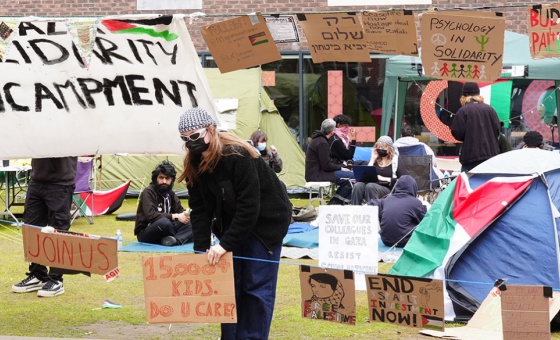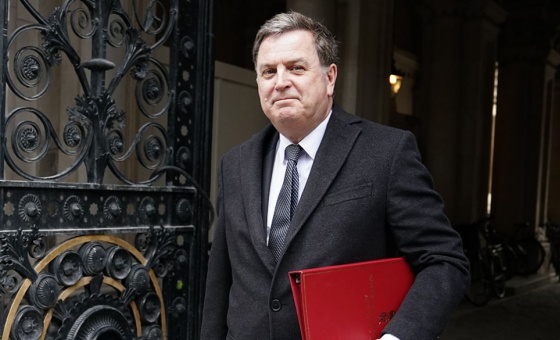This is the last article you can read this month
You can read more article this month
You can read more articles this month
Sorry your limit is up for this month
Reset on:
Please help support the Morning Star by subscribing here
ON FEBRUARY 27 1933, 90 years ago, Berlin’s parliament building, the Reichstag, was set alight, less than a week before polling in national elections was due.
National Socialist Party leader Adolf Hitler, appointed chancellor four weeks earlier by president Paul von Hindenburg, seized the moment to declare total war on democratic processes and political opponents, and in the hope of maximising electoral support for the Nazi party.
In Britain, the next day, Labour’s Daily Herald reported the fire, “said to have started in five or six places at once,” and the cause of which was “a complete mystery.”
The paper’s special correspondent in Berlin drew attention to the background of “an almost unimaginable campaign of force, intimidation and government-controlled propaganda.”
Reference was also made to a speech to come from Hitler on March 4, the eve of polling day. “Every street in Germany is to echo [his] voice while his opponents and his critics are forced to remain silent.”
Despite Nazi manipulations, the parliamentary election on March 5 won the Nazi party, which had been funded handsomely by financiers and industrialists, only 44 per cent of the vote.
But henceforth elections were to be an unnecessary luxury. The country’s rearmament, overruling severe limitations imposed by the World War I Versailles settlement, would now proceed, as would ever-increasing persecution of Germany’s Jewish residents.
The Nazis had suffered a setback in the previous Reichstag election results declared in early November 1932, losing two million votes gained previously, and receiving just under a third of the turnout, while the much smaller communist vote had risen.
The combined communist and social democrat voting total was above 13 million. With less than 12 million votes, the Nazis were on the defensive. They required “special measures” to gain supreme power.
Fresh elections were announced on February 1 1933, two days after Hitler’s appointment. Anti-democratic developments came swiftly.
A presidential decree of February 4 enabled the government to curtail press freedom and introduce “protective custody” (ie arbitrary arrests and imprisonment).
As Hitler’s biographer Ian Kershaw explains, accompanying the election campaign “was a wave of unparalleled state-sponsored terror and repression against political opponents in states under Nazi control” (at that moment ie, most of Germany).
Prussian police were now ordered by Nazi interior minister Hermann Goering to work together with Nazi stormtroopers, while communist gatherings were prohibited.
To destroy political opposition, and to maximise their public support in the new elections, the Nazis required the biggest of lies.
Vital for their power grab was the elimination of the communist party, backed the previous November by six million voters, as a parliamentary force. On February 24 police raided the communist party’s Berlin headquarters.
The claim was immediately made that leaflets found there called for armed revolt, and a press statement by Goering asserted that political assassinations and other violence were intended too. No evidence supporting these charges was ever forthcoming. They were lies.
But then came the Reichstag fire, in the words of Allan Merson, historian of communist resistance to Nazi rule, “a highly imaginative act of provocation … used to whip up a wave of panic and anti-communist hysteria and so to obtain acceptance of presidential legislation suspending the constitutional rights of the individual.”
As early as the following morning an “emergency” decree suspended indefinitely the rights of individuals to freedom of speech and association, and to private communications by post and telephone.
During the night of the fire, and in the following days, an estimated 1,500 communists were arrested in Berlin, and an estimated 10,000 across the country.
By April, some 25,000 people became victims of “protective custody.” Beatings, torture and murder by the custodians were rife.
On March 23, the newly convened parliament (with 81 communist deputies now excluded from seats but not from prison, and 288 Nazi deputies plus allies, triumphantly outvoting 94 social democrats), abolished itself through an “Enabling Act.”
This transferred the powers of passing legislation, of budgetary control and the business of making treaties with foreign states, to the Reich cabinet. Hitler was now Germany’s dictator.
The firing of the Reichstag does not have much mysterious about it, other than murky matters of detail. William Shirer, in his early and formidable Rise and Fall of the Third Reich, noted that most of those in the know were slain by Hitler’s men in the months that followed, and that the full truth would never be known.
But he concluded that “there is enough evidence to establish beyond a reasonable doubt that it was the Nazis who planned the arson and carried it out for their own political ends.”
Almost certainly, he added, the idea originated with propaganda chief Goebbels and with Goering, whose residence was a short distance from the Reichstag and connected to it by an underground passage.
Promptly arrested as an arsonist was a former Dutch communist in his mid-twenties, Marinus van der Lubbe, apparently mentally disturbed, and claiming sole responsibility.
Nevertheless, the Nazi leaders instigated a trial that autumn of those they alleged, together with van der Lubbe, were responsible.
These were German communist party deputy Ernst Torgler and three Bulgarian communists including Georgi Dimitrov. If the Reichstag fire frame-up had plausibility for some Germans, the later trial was a fiasco, save for the conviction of van der Lubbe, who, a victim as much as a culprit, was beheaded.
The others were acquitted. Dimitrov, representing himself, memorably exposed Goering in cross-examination as the gangster he was. (Dimitrov: “Are you afraid of my questions, Herr Ministerprasident?” Goering: “You wait until we get you outside this court, you scoundrel!”)
A first detailed exposure of the frame-up (while presenting some conjectures as facts), and also of the terror that preceded and followed it, was made in The Brown Book published in Britain in September 1933.
This was masterminded by German communist deputy and publicist Willi Muenzenberg, an escapee from Germany to France in reliance on the passport of a much younger man.
Hitler’s arrival in power produced action in Britain, where a Relief Committee for the Victims of German Fascism was established by communists and left-wing Labour allies.
The committee sponsored a “counter-trial” (which immediately preceded the real thing in Leipzig), presided over by Labour candidate and barrister DN Pritt.
The inquiry heard exiled witnesses, exonerated the four accused communists, and concluded that there were grounds for suspecting Nazi complicity in the fire.
At the annual Labour conference Ellen Wilkinson spoke eloquently: “Why are not the great democratic forces of this country behind the efforts to unmask that great conspiracy of the Nazis which was used to destroy democracy in Germany?”
The Labour leadership, like the “national” Ramsay MacDonald government of the time, was disapproving of the relief committee and the counter-trial.
A journalistic force on the left in the form of Claud Cockburn’s news-sheet The Week had first appeared on March 29 1933.
It had then drawn attention to Hitler’s long-term aim with the words: “In an article published just before his accession to power, Hitler himself strongly hinted at the dismemberment of Russia as a solution of the acute rivalries between the European powers.”
It was a plan which successive British governments failed to oppose, thereby encouraging aggressive German expansionism — and another world war.
It is fair to mention the credence given by Richard Evans (whose Third Reich history has great value) to the attempts made by Fritz Tobias and others from the late 1950s onwards to justify the conclusion that the fire was a gift to the Nazis by van der Lubbe and not essentially their own operation.
Evans has viewed the Nazis more as opportunists than conspirators. But the invented blame for communists days before the fire was in itself proof of a frame-up strategy.
The Nazis then had powerful reasons for launching the fire as an incriminating theatrical extra, and for attempting to conceal their role from public view.
The weakness of the then Labour leadership’s commitment to broad-church anti-fascist action brings to mind the present Labour leadership’s zealous support for the dangerous causes of Nato and the US.










